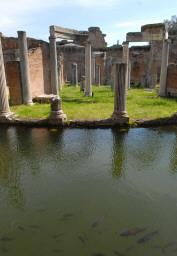The Roman Emperor Hadrian is set to be London's most popular guest celebrity this summer, with the opening of a major new exhibition devoted to his life, loves and achievements.
Hadrian: Empire And Conflict, which opened at the British Museum this week, brings together over 180 priceless artefacts, sculptures and architectural fragments exploring the legacy of one of Ancient Rome's most famous rulers.
Hadrian, who was emperor from 117 to 138 AD, is best known in the UK for his construction of a coast-to-coast wall spanning the width of northern England, which once marked the northernmost outpost of the Empire.
He has also gained renown for his love of Greek culture, his ruthless military achievements and his passionate devotion to his young lover Antinous, whom he deified after his death.
But the organizers of the London show are keen to paint a more rounded picture of the emperor, with a particular focus on the many apparently contradictory facets of his personality, such as his ruthless suppression of dissent and his cultural tolerance.
One particularly brutal example of Hadrian's determination to stamp out opposition was his response to the Jewish Revolt of 132 AD, after Judaism was banned and circumcision outlawed.
Reports at the time suggested that half a million Jews were killed or starved to death.
Rumours that farmers did not need to fertilise the blood-soaked land for eight years afterwards cannot be proved but a number of items that belonged to Jewish rebels hiding in caves near Jerusalem have survived the centuries and are on show in London.
Yet Hadrian was also considered a cultured, open-minded man, fascinated by architecture and other civilizations, particularly that of Greece.
Considerable space will be devoted to recent finds from excavations at his villa, now a UNESCO World Heritage Site in Tivoli, a town not far from Rome.
These finds included the groundbreaking discovery in 2002 of a lavish shrine devoted to Antinous, who drowned in the Nile in AD 130.
The excavations uncovered the walls of a semi-circular room and a number of Egyptian-style artefacts, some apparently brought back from Egypt by Hadrian and others made in the Egyptian style that was fashionable at the time.
In addition to the dozens of items on loan from institutes around the world, the exhibition will feature a selection of pieces usually stored in the British Museum, such as the Vindolanda Tablets.
These are a collection of letters in ink on scraps of thin wood, excavated at a fort near Hadrian's Wall and dating back to the 1st and 2nd centuries AD.
They were written by and to a variety of people: soldiers, merchants, women and slaves, and create a vivid, personal sense of what life was like for everyday people in the outposts of Hadrian's Empire.
Hadrian: Empire And Conflict is on show in the British Museum until October 26.









